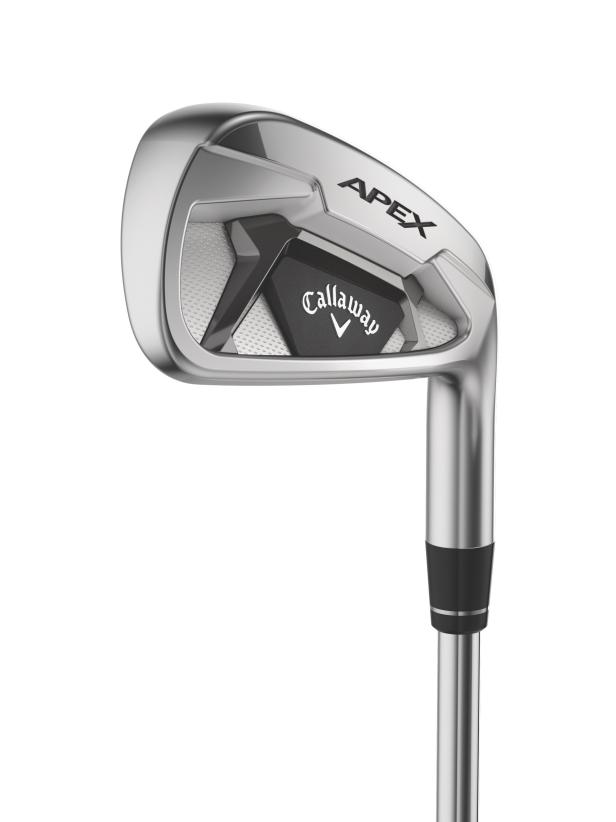Products You May Like
What You Need to Know: All three Apex irons have cupfaces designed by artificial intelligence and tungsten encased in urethane with microspheres (tiny bubbles of air within the urethane). The two technologies combine to boost ball speed across a wide portion of the face. The Apex and Apex Pro hybrids provide an alternative to the long irons in two distinct ways.
Price: All Apex irons and hybrids will be available in stores Feb. 11. The irons cost $185 per iron in steel and $200 in graphite. The Apex hybrids cost $270 and come in lofts of 19, 21, 24, 27 degrees in Apex and 18, 20, 23, 26 degrees in Apex Pro.
The Deep Dive: When Callaway Golf introduced its 2019 versions of its Apex irons it had been three-plus years since the company had provided an update of its most popular iron line. For fans of these irons, thankfully the latest iterations—Apex 21, Apex Pro 21 and a entirely new Apex DCB—didn’t take quite so long.
Helping speed things along was the use of artificial intelligence which helps engineers more rapidly figure things out. In this instance, designing faces for each individual iron in the set to optimize performance. In another improvement to the Apex 21, the face cup (where the face wraps around part of the topline and sole) not only brings more face flex, but this trait now extends all the way to the 9-iron.
Tungsten (ranging from 14 to 64 grams) encased in urethane with microspheres (tiny bubbles of air within the urethane) not only help foster trajectory control, but help allow the face to flex more at impact, too. The amount of tungsten is up to five times the amount found in the previous Apex.
“The face cup and tungsten doesn’t just help center shots,” said Scott Manwaring, Callaway’s director of iron design. “It broadens the area the face can flex. A face plate limits the amount of area. Having the high-strength material for the face allows you to recover spin rate and have ball speed consistency in ways you can’t get with a face plate, especially on shots hit low on the face.”
The body on the Apex 21 is forged from 1025 carbon steel and the sole has been revised to help the club plow through the turf more easily.
While the Apex 21 is driven by distance, the Apex Pro 21 is more of a tool for those taking a surgical approach to their iron game. But don’t let the sleek, forged, 1025 carbon steel hollow body construction fool you into thinking the pursuit of additional yards was ignored. In fact, Callaway brought an A.I.-designed face cup in an iron for the first time, providing each face its own unique structure to maximize ball speed and spin.
Like the Apex 21, the Apex Pro 21 uses as much as 90 grams of tungsten—the most ever used in an Apex iron—encased in urethane with microscopic air bubbles to assist feel. It also gets the CG low in the long and mid irons while providing a forgiveness boost.
The new Apex and Apex Pro are solid upgrades to existing models that better players will welcome. But what about the player that needs a little more help? That golfer had been shut out of the Apex line … until now.
The new Apex DCB irons brings the forged Apex offerings to an entirely new group of players, combining the look of a players iron with the forgiveness provided by a cavity back that is a touch deeper and a sole a skosh wider than the standard Apex model.
As part of the Apex line, it, too, uses an A.I.-designed face cup that goes from the 4- through 9-irons for distance and height, as well as borrowing the tungsten (up to 50 grams) encased in microsphere-filled urethane. That lowers the CG positions to produce plenty of launch despite slightly strong lofts.
Of course, knowing that those using Apex irons might want to substitute hybrids for their long irons, Callaway also is bringing out a pair of hybrids: Apex and Apex Pro. The Apex Pro is the slimmer of the lot and looks very much like a players hybrid and plays like it, too, with a lower launch and a touch more spin. The Apex is larger, includes an adjustable hosel to tweak launch angle and has tungsten in the back to add forgiveness and lower spin.
Applicable to both is the use of A.I. to design the new cupfaces (using forged 455 steel) and a re-imagined form of the internal “Jailbreak” blades that join the crown and sole. The face and blades work together to produce greater face flexing for more rebound, especially on shots hit high and low on the face—or where most everyday golfers hit them.
All Apex irons and hybrids will be available in stores Feb. 11. The irons cost $185 per iron in steel and $200 in graphite. The Apex hybrids cost $270 and come in lofts of 19, 21, 24 and 27 degrees (Apex), and in 18, 20, 23 and 26 degrees (Apex Pro).


